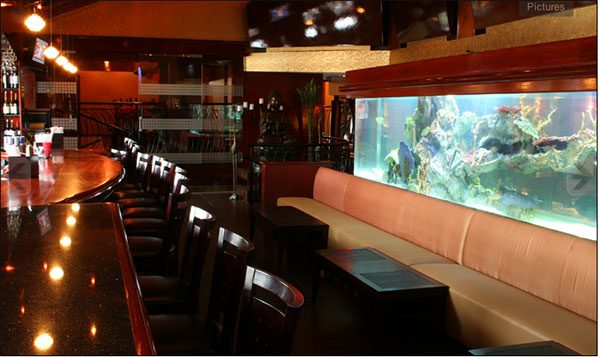


Brightly colored tropical fish dart in the saltwater tank that runs parallel to the bar; a larger-than-life Buddha in the main dining room sets his serene gaze upon you; keen ears pick up the sizzle of hibachi grills and clacking of sushi knives over the celebratory din; nostrils quicken to the piquant aromas of Asian sauces and spices rising from those grills. Once your food is served, your taste buds will join the party, grazing amidst a vast selection of Japanese, Chinese, and Thai dishes.
The two-story, 380-seat space opened in January 2007 after two years and $3.5 million in renovations to the building that formerly housed Meritage restaurant. It has been drawing a steady stream of customers ever since—thanks to its proximity to the Shore a few miles east, and the Parkway (it’s right off Exit 98).
Owner Patrick Chu, who was born in Hong Kong and has been in the restaurant business for 40 years, has put plenty of show in Shogun. “We have fine dining downstairs where people can have a nice dinner with no kids running around,” he says, “and hibachi upstairs, which is good for families.” (Chu runs the restaurant with his wife, Jolene Chen, originally from Shanghai. The couple also own Shogun at Bay Lea, in Toms River.)
In addition, Shogun Legends features a horseshoe-shaped, elevated bar that has become something of a pickup scene. (Conversation starter: the 2,000-gallon aquarium. Patrons can eat at the bar or in one of the low banquettes that front the 20-foot-long fish tank.) An extensive drink menu includes more than ten sakes and two dozen specialty drinks, such as the Blue Hawaii, a sweet blend of vodka, curaçao, pineapple juice, and orange juice, or the Tokyopolitan, which successfully subs sake for vodka, adding triple sec, lime, and cranberry juice. Another sake-based drink, Asian Pearsuasion, though thick with pear purée, failed to balance the astringent zing of the sake.
The dining room is outfitted in warm woods, red-print upholstered booths, and red wooden columns interspersed through the room—a lush setting for cuisines often served in more minimalist surroundings. At the back of the dining room is a sixteen-seat sushi bar. We tried the sushi sampler, an eight-piece platter disappointingly heavy on tuna, and the lobster roll, eight pieces rolled from sticky rice and brimming with lobster meat. Yellowtail jalapeño sashimi was so thinly sliced we could barely taste the fish.
An extensive appetizer menu spans the Asian palate. We sampled Shanghai eggplant, a beautifully plated fan of grilled baby eggplant filled with a creamy shrimp stuffing, and four small but delicious vegetable-filled steamed dumplings served with an herb and spicy-oil sauce that Chu said was Chef Wah Cheng’s secret recipe. We had a Japanese seaweed salad of tender tendrils in a sesame-oil dressing, and excellent shrimp tempura—a platter of lightly battered shrimp, eggplant, yam, and golden melon generous enough to serve as an entire meal (for $8). Among Thai-influenced dishes, we tried green-curry chicken (red and yellow curries are also available), a green-pepper-based sauce that combined sweetness with a spicy finish.
Ordering can be a challenge since prices and descriptions don’t necessarily reflect the amount of food served. For instance, the Gold Coin filet of beef, served in a peppercorn-and-pomegranate oyster sauce, proved sparse at $30, while crispy whole fish, at $38, brought forth a 2.5-pound sea bass. The fish is a showstopper, its flesh fanned out from the bones before being deep fried and served with a garlic sauce.
For more showmanship, repair to the hibachi room upstairs, where five or more chefs with flashing blades man fifteen hibachi tables. Be prepared to endure a kid’s birthday party or a bachelorette bash, often at the other end of your table (they seat ten to twelve). We shared our table with two couples who failed to catch bits of zucchini the chef tried to flip off the grill into their mouths. Our smugness faded when our turns came and we failed at the same task, one piece of zucchini dropping into my blouse. In addition to having us play trained seals, our chef tossed up a piece of food and caught it in his hat (it was then discarded), lit a flame inside a stack of onion rings, and, thankfully after all this schtick, served up moist, tasty meats, fish, vegetables, lo mein, and fried rice in record time. In addition to the selected protein ($20-$36), hibachi meals include clear soup, salad with ginger dressing, grilled shrimp appetizer, and ice cream.
Dessert is surprisingly limited, considering the breadth of the rest of the menu. Lemon tart was sufficiently tart but had a soggy crust. The tempura coating on the Banzai Banana roll was properly crisp, but the ice cream filling had a perfumy aftertaste. The most interesting dessert we tried was Japanese mochi ice cream, four dollops of mango ice cream wrapped in mochi (soft rice pastry) providing a sweet, chewy contrast to the tart, cold center.
Restaurant Details
- Cuisine Type:Asian - Sushi
- Price Range:Expensive



